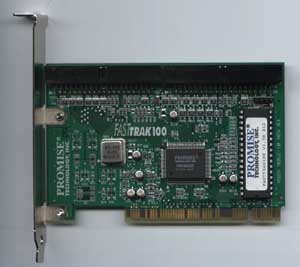AMI MegaRAID 100
The American Megatrends MegaRAID 100 is a software IDE RAID controller that makes use of the American Megatrends MG80649 controller. This is the same IDE RAID controller that is found on a few motherboards out there, including ones from Iwill. There is actually no difference between the PCI card version of the MG80649 and the integrated version: both work over the PCI bus to provide identical IDE RAID capabilities and performance.
The MegaRAID 100 is an ATA100 RAID controller, meaning that it supports speeds up to the current ATA100 spec. The chip on the card is capable of supporting up to a total of 4 drives on two IDE channels, just like every other IDE controller. The card features pin-outs for hard drive activity LEDs on both the primary and secondary channel as well as a jumper for enabling or disabling the onboard BIOS.
Iwill SIDE RAID100
The second software RAID card we got the opportunity to test was the Iwill SIDE RAID100. This card is powered by the HighPoint HPT370A chip that is found on many motherboards including those by ABIT and EPoX.
Like the American Megatrends offering, the HighPoint RAID controller features two IDE channels (primary and secondary) that support drive speeds up to ATA100. Our card had a single connection for a hard drive activity LED over both channels of the card.
Promise FastTrak100
The final software RAID card used in the tests was the Promise FastTrak100 IDE RAID controller. This card makes use of the Promise Technology PDC20267 ATA100 software RAID controller, the same one found on some motherboards manufactured by MSI as well as others.
Just like every other software RAID card we have seen, the Promise FastTrak100 and its PDC20267 chip provides two IDE channels, both of which support ATA100 speeds. The reason that all software RAID cards are the same when it comes to their number of channels is because they really are nothing more than an IDE controller, just like the one found integrated in every southbridge. The card also featured a 4 pin-out LED connection to power up to two hard drive activity lights.













2 Comments
View All Comments
kburrows - Thursday, December 4, 2003 - link
Have you run any tests on any onboard RAID solutions for RAID 0 & 1? I would love to see the results posted for the new SATA RAID on the Intel 875 boards.Anonymous User - Sunday, August 17, 2003 - link
In adressing the performance of an raid array with different stripe sizes, you miss an important factor, namely the accestime of an disk. This wait time has two main couses. First the head positioning and second the rotational latency (the heads track the right trace, but position where the read start has not passed under the head). You may have to wait from 0 to (in the worst case) a full cycle.Since the disks move independently You can calculate that the average latency to get an small file is minimal when the stripe size is about an full cycle of an disk in the array (aprox. 250kB today). All other factors I do know do not reduce this. (controller overhead, transport,...)
So I think that today a minimum stripe size of 256kB should be used.